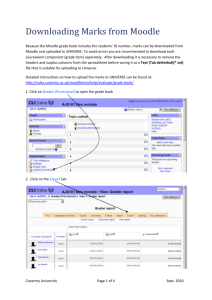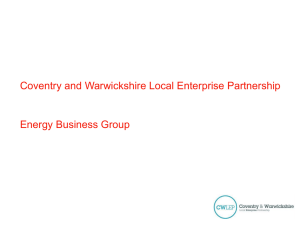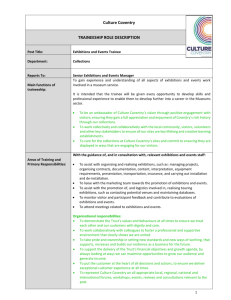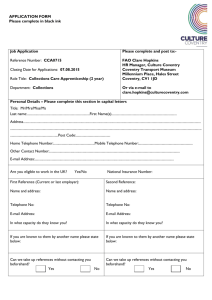Impact presentation – Warwick 260214 HANDOUT FINAL VERSION
advertisement
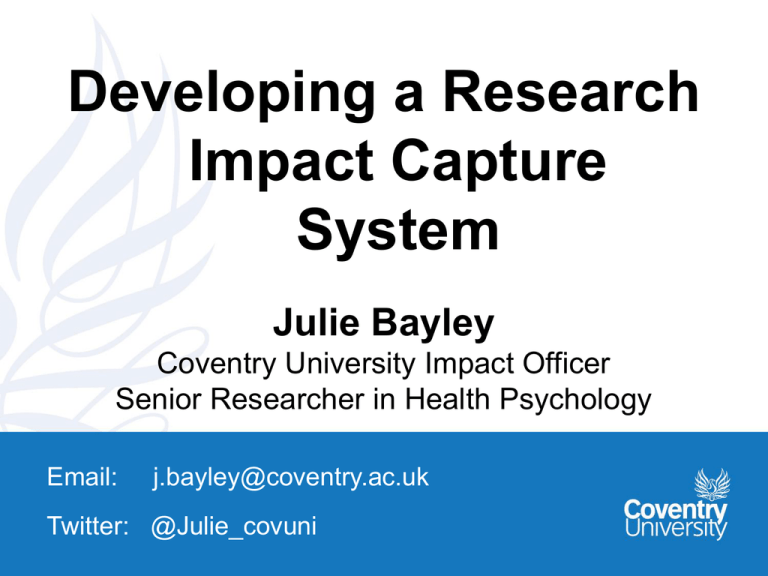
Developing a Research Impact Capture System Julie Bayley Coventry University Impact Officer Senior Researcher in Health Psychology Email: j.bayley@coventry.ac.uk Twitter: @Julie_covuni Overview 1. Context and Coventry University approach 2. Impact Capture System (‘ERIC’) 3. Experience and learning Context • Increased impact weighting (REF 2020) and funder requirements • Ongoing discussions on measurement, assessment and definitions • Related drives eg. Open Access • Increasing focus on how to embed change institutionally • How do we develop a systematised approach? Coventry University approach • “Embedding Research Impact at Coventry” (ERIC) – JISC funded project, May-Nov 2012* – Develop and test a prototype Impact Capture System • Commissioned by the VC to rollout across CU • Programme of work to develop system and engage academic staff – Revise / extend content and structure – Academic, business and strategic consultation • Strategic commitment and sustainability planning *http://www.publicengagement.ac.uk/about/impact-analysis Prototype development process 1. Impact needs analysis Business and Community Engagement 2. Create content 3. Technical process review / system adaptation 4. Pilot test system Research Information Management Research Pilot Purchase database External literature / guidance Full rollout Consultation and engagement across faculties Full launch Modify/ extend database Embedding ‘ERIC’ system • Built within existing CU Research Information Management system • Add details of (multiple) planned impacts, those which occur unexpectedly or remove those which do not transpire. • 4 steps to add an impact….. 1. 2. 3. 4. Plan impact (4 drop down boxes) Plan evidence Set/ receive email reminders Add/ update evidence Learning and experience • Benefits of ERIC – ‘Institutional memory’ – Flexible system supports impact planning from project inception – Build and monitor ongoing impact portfolios – Reduced reporting burden for REF 2020 – Support funding bids / reports to funders – CU marketing, case studies and reputation building Challenges • • • • • • • • • Experience of REF 2014 Impact not well understood Impact is not static or universally accepted Very difficult to standardise across disciplines Scepticism and suspicion Control of information Ownership and attribution of impact Bridging academic / business divide Combining narrative with metrics Consultation summary (Barriers) Barriers Frequency Time constraints and workload 18 Issues with research management system (access, familiarity) 12 Limited awareness and understanding of impact / benefits of system 9 System difficulties 6 Attribution and tracking of impact 5 Opportunities • Accommodate non-funded projects • Build academic awareness of system and impact • Develop tools for enhancing impact planning / measurement • Change of research management system • Growth of impact culture Consultation summary (Facilitators) Facilitators Frequency Training and support 20 Raise awareness of impact and system System edits 18 16 Link and embed across university practices 10 Utilise / report data (inc. REF 2020) 6 Improve ease of access 4 Increase relevance to academics / academic practice 3 Making it work…. • • • • • • Partnership is key ‘Engage not enrage’ academics Top-down support for bottom-up development Across-university system interaction Continued dialogue and revision Centralised and committed approach, locally translated Next steps • • • • • • Continue building and rolling out system Embedding impact and behaviour change Build impact infrastructure Training System changes Dissemination (papers, reports, blogs) Thank you and questions Julie Bayley j.bayley@coventry.ac.uk Twitter: @Julie_covuni






